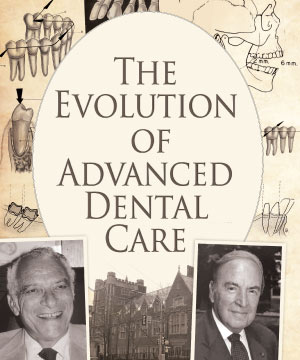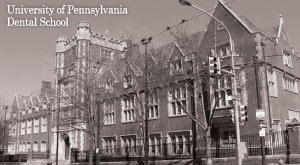The Evolution of Advanced Dental Care

Of the many pioneers in the art of medicine, only a few receive much recognition outside their own specialized fields. Perhaps some know the name Dr. Christiaan Barnard, who performed the first human heart transplant in 1967, or Dr. Jonas Salk, who developed a vaccine in 1952 to combat the scourge of polio. But how many remember the crucial contributions of Joseph Lister to today's concept of antiseptic surgery — or Edward Jenner, who developed the very first vaccine against the then-dreaded disease smallpox? And, outside the field of dentistry, how many have heard of the innovative work of Dr. Morton Amsterdam?
A clinical practitioner and professor at the University of Pennsylvania School Of Dental Medicine, Dr. Morton Amsterdam developed a method of treating advanced dental disease that is known as “periodontal prosthesis.” In this way, it allowed individuals who were in imminent danger of losing all of their teeth and who would have previously been considered untreatable — to keep them. The principles and practices developed by Dr. Amsterdam, in collaboration with his trusted friend and colleague, Dr. D. Walter Cohen, now dean-emeritus of the University of Pennsylvania, allowed these patients, through the miracle of periodontal prosthesis, to retain as many natural teeth as possible, restoring them to proper health, function and appearance.
To really appreciate the contribution of Drs. Amsterdam and Cohen, it is necessary to recall the state of the art of dentistry in the years following World War II. Clinical dentistry had made great strides by mid-century, but there were then only two recognized dental specialties: oral surgery and orthodontics. The other specialized areas we are familiar with today were yet to be recognized.
Yesterday, Today And…
At the time, saving the natural teeth was not a high priority, although when it came to taking care of simple maladies like toothaches and cavities that was routine. But when it came to resolving the more difficult-to-treat cases, the prevailing philosophy of the era could be summed up as follows: “Take out teeth, put in dentures.” Yet before their clinical careers were over, the work of Drs. Amsterdam and Cohen would contribute to changing that old practice into a new paradigm: preserving teeth whenever practical.
Early in his career, Dr. Amsterdam began instructing dental students, and he eventually became Chairman of the Department of Endodontics at Temple University. Dr. Louis Grossman, who developed techniques in endodontics (root canal treatment) to save teeth, greatly influenced him. This really sparked a passion in Dr. Amsterdam — and, after all, saving teeth is something for which all dentists should have a passion. This led to the next area of investigation: Once those teeth were saved, how then to restore them?
Dr. Amsterdam spent countless days in study, reviewing all the basic sciences and discovering ways to better apply his knowledge to clinical situations. He took on cases other practitioners didn't want to handle — he often seemed to have a sixth sense about why their mouths were breaking down and an uncanny intuition about what treatment would be most effective for their particular situations. When he needed to harness additional restorative expertise, he found three prosthodontists, Drs. Lewis Fox, Lewis Alexander Cohn and Jerome Schweitzer, all great mentors, to help him develop restorative techniques to save teeth. He would later use these insights to fully develop and conceptualize the treatment philosophy he called periodontal prosthesis.
On the basis of their own experience, Drs. Amsterdam and Cohen understood that it was necessary to bring together knowledge from all the various specialties of dentistry in order to make an effective treatment plan for a patient. This included the burgeoning fields of endodontics and periodontics (a dental specialty concerned with the structures that surround the tooth, including the gums and underlying bone tissue). They also saw that developing an effective treatment plan was the key to a successful treatment.
It Takes A Village

When Dr. Cohen assumed the deanship at the University of Pennsylvania, he and Dr. Amsterdam made periodontics the bulwark of the teaching program. In addition he changed the relationship from the top down — teacher to student, to professional to professional. No matter what dental specialty a student undertakes, a thorough knowledge of the underpinning of dentistry — periodontology — is mandatory. Drs. Amsterdam and Cohen gave their first annual lecture on periodontal prosthesis in 1958. Their unique and successful approach to treatment of advanced dental disease spread amongst anyone and everyone they taught — all over the world.
In 1974, some 25 years after he began to formulate and refine his concepts into treatment protocols, Dr. Amsterdam published a landmark article on the art and science of periodontal prosthesis. Through meticulous and painstaking documentation of each case, over 2500 at that time, he was able to show how successful one could be using his approach. This paper established the methods he pioneered as a fully developed, comprehensive philosophy of care.
Only after an accurate diagnosis is made — what is actually causing disease — can a comprehensive treatment plan be developed for each individual patient. This is one of Dr. Amsterdam's most basic tenets; furthermore each step taken in treatment should confirm the diagnosis, as the patient responds positively to the treatment program. If not, he surmised, something had been missed, necessitating a review of the diagnosis.
After developing the treatment plan, the next step in the process is controlling or eliminating the multiple causes of disease. This primarily included periodontal treatment to control inflammation and infection of the periodontal gum tissues, and of course tooth decay. This set the stage for defining final form, function and aesthetics of the rehabilitated teeth, which would include a properly sequenced plan including the other dental specialties.
Tomorrow
The concept of periodontal prosthesis urges dentists to take an interdisciplinary approach to solving complex dental problems and in this respect, it foreshadowed contemporary research in fields as diverse as neuroscience, cybernetics, biochemistry and biomedical engineering. It stresses the importance of coordinating care from different specialists — and it also underlines the need for practitioners to have a firm foundation in basic science on which to build a diagnosis and treatment plan.
Even today, some six decades after it was first developed the concept of periodontal prosthesis is able to seamlessly incorporate the newest advances in dentistry into its overall (interdisciplinary) treatment philosophy. For example, with the current wide availability of dental implants, it is imperative to consider these tooth replacements within the context of how they fit into the restoration of a patient's oral health, if they are to be successful. Periodontal prosthesis provides the framework for this new endeavor.
For over 50 years, Dr. Amsterdam and Dr. Cohen saved teeth that were plagued with advanced cases of disease. Thousands of patients flocked to their offices, including a few wealthy globetrotters. Yet he also worked on countless patients from the Philadelphia neighborhoods around his school and office.
We Stand On The Shoulders of Giants
Besides their clinical work, Drs. Amsterdam and Cohen passed on their philosophy of treatment to generations of students, many of whom in turn have become great teachers in the field today. Their educational program gave students the ability to understand the fundamentals of diverse dental specialties, even if they weren't intending to practice in those areas.
And when asked what is the greatest of their many accomplishments, they both will humbly and unequivocally say, “How proud we are of our students.”
In synthesizing the knowledge they gained from tireless clinical work, organizing it into a comprehensive system and passing it down to generations of new dentists, Dr. Morton Amsterdam and Dr. D. Walter Cohen helped to establish a new and more sophisticated approach to patient care. Their interdisciplinary approach is still widely used today, and has proven particularly valuable in resolving the difficult cases they often took on in their own dental chairs. Their long and distinguished careers offer proof that the contributions of a few dedicated individuals can indeed change the way medicine and dentistry will be practiced in the future.

